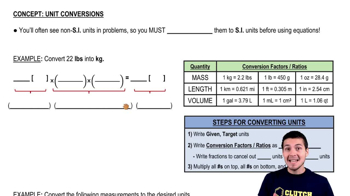Here are the essential concepts you must grasp in order to answer the question correctly.
Kinetic Energy
Kinetic energy is the energy an object possesses due to its motion, calculated using the formula KE = 1/2 mv², where m is the mass and v is the velocity. This concept is crucial for comparing the energy of different objects in motion, as it directly relates to both their mass and speed.
Recommended video:
Intro to Rotational Kinetic Energy
Mass and Velocity Relationship
The relationship between mass and velocity is fundamental in understanding how kinetic energy varies with changes in these parameters. For two objects to have the same kinetic energy, adjustments in either mass or velocity must be made, illustrating the inverse relationship between mass and the square of velocity in the kinetic energy formula.
Recommended video:
Unit Conversion
Unit conversion is essential when dealing with different measurement systems, such as converting kilometers per hour (km/h) to meters per second (m/s). This ensures consistency in calculations, particularly when comparing the kinetic energies of objects with different masses and speeds, as accurate units are critical for correct results.
Recommended video:



